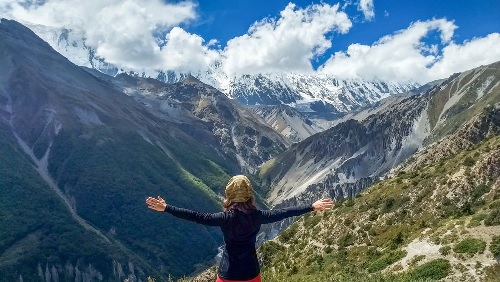The Annapurna Circuit combines challenges and rewards in equal measures, an immersive multi-week expedition where physical endurance and mental grit are your only way forward. For trekking thousands of miles and up any of the daunting heights around Thorong La Pass, all you need isn’t a good pair of boots—it requires a smart eating plan to keep your body (and brain) plugged in; fatigue on the trail can lead to altitude sickness, or it can simply make you not like the Himalayas very much. Armed with a fundamental understanding of how to eat, drink, and pace their effort on any uphill, trekkers can ensure their system is capable of delivering in a range of environments, from sweaty subtropical forests to high, cold deserts. This ultimate guide provides the low-down on all essential strategies for managing energy for a good trek.
The Fuel Source: Carbs, Carbs, and More Carbs at Altitude
Your body’s general metabolic activity shifts to carbohydrate use by far when it doesn’t have as much oxygen at altitude. Unlike fat or protein, carbs require relatively little oxygen to be turned into energy — they give your body the biggest bang for a small supply of limited oxygen. So up your hiking diet to super high carb. The Nepalese staple Dal Bhat (lentil soup and rice) is the trekker’s best-kept secret; it holds slow-burning complex carbs for sustained energy, and vital proteins from the lentils to aid in speedier recovery of your battered muscles. Other things to eat: good alternatives are Tibetan Bread or Porridge for breakfast, and potato-based snacks such as Fried Potatoes, Aloo Chop (potato ball), etc. However, resist consuming large, oily foodstuffs or loads of meat at high altitude; they’re difficult to digest and can make you feel slow-motion, springy-doughy.
Protein and Healthy Fats are a Recovery Powerhouse
Yes, the carbs are a nice little “Oh, hey, good morning!” pick-me-up, but protein and HEALTHY fats are necessary for muscle recovery/rebuilding post-workout AND an energy source when those quick carbs have come and gone. It’s grueling work to hike a hill, and protein will be among the nutrients that help repair those tiny tears you’re producing in your muscles, so it should definitely show up at dinner. Another safe and easy protein bet can be found at most teahouses – eggs cooked scrambled or into an omelet. Then there are the lentils that come with your Dal Bhat as a good source of protein for you during the day. By contrast, rich fats from foods like cheese, nuts, and peanut butter are calorically dense with a slow-burning energy that will keep a dieter sustained throughout his or her day – a necessary reserve fuel both in the days before a shred of hard-core backpacking action and during it.
Hydrate: The Silent Enemy in Energy and Acclimation
Keeping well-hydrated is perhaps the most crucial component to feeling strong and healthy at altitude. “As you’re walking up and down mountains, there are some days when you just stop sweating after a while,” he said in an interview near Everest’s southern base camp, where thick cords of prayer flags snap in the wind, on Monday morning. The trouble with dehydration is that your blood thickens, and as a result of this, the body has to work even harder to pump its oxygen around itself – exacerbating feelings of tiredness and symptoms associated with ‘Acute Mountain Sickness (AMS)’. You should be working towards drinking a minimum of 3–4 liters of water per day. – more if you are climbing up in altitude. Hydrate with warm liquids like ginger tea, garlic soup (not just cause of the way it looks in Harry Potter) to adjust, and sometimes the odd electrolyte drink to replace those lost salts. Dehydrating agents like alcohol and excessive caffeine should be limited.
Smart Snacking: How to Outsmart the Mid-Day Energy Slump
On a long day trek, you need those food halts -no one likes feeling grumpy around mid-morning or mid-afternoon due to lack of energy! Don’t rely on 3 meals a day, get more calories and protein instead by incorporating snacks high in calories (and easily digested) every few hours. These trail snacks are something to carry with you, not only buy them on the path where pricing changes as fast as it’s throwing range. Local options can be roasted soybeans (Bhatmas), which are also a good protein fill-up. This flow of fuel … [keeps] the blood sugar level stable, which is essential not only for physical stamina but also mental fortitude.
Introduction to the art of pacing: The principle of ‘Poley poley’
No meal is strong enough to make up for a poor pacing strategy! For Annapurna Circuit Trekking (Nepal), the old Nepali mantra of Poley Poly (slowly, slowly) is what will really keep your energy up on this breathtaking and challenging Nepal trek. Just stay at a pace that feels good and doesn’t make you breathless for the next few hours. If anything, ascending quickly only increases the body’s oxygen/energy usage, leading to quicker bears out and higher chances of AMS. Rest.) pauses on the way down (and apply the” rest-step”), get a little ‘micro-rest’: with every step upwards, maintain( ing)” your blood pressure and preserving precious energy. Short-release breaks, five to ten minutes per hour, are better than periodic long ones.
The Mental Game: Attitude And Positivity
Trekking is not simply a physical test but also a mental one. Fatigue is frequently caused or exacerbated by negative thoughts or too much focus on the end goal. Engage your guide or fellow trekkers in conversation or simply focus on your breath and the sounds of you’re feet steady mark against the ground. Reminding yourself to be lifted by the tiniest victory — reaching the day’s lunch stop — helps baby your psychological charge at least as much as calories in your tank.
Contribution of Acclimatization Days to Energy Balance
Annapurna Circuit Trek Relaxation days, inclusive of the only ones that are normally deliberate in Manan, are not covered just to avoid AMS, but also serve as a strength-saving mechanism. Observe: these aren’t days of relaxation in bed; however, “climb excessively, sleep low” days. By means of trekking a clean few kilometers uphill to another standpoint or avenue and descending back down to the lower village altitude, you may permit your body to begin being used to less available oxygen. This slow system of acclimatization considerably reduces the overall strain to your frame whilst climbing high and fast, leaving you fresher inside the very last ranges as compared to some other approach.
Final Thoughts on Sustained Energy
The Annapurna Circuit is about being well nourished and supported; it’s not so much about fuelling as it is about flourishing, using good nutrition to body your way to the highs while cushioning you from crash landings. It’s not, it’s knowing the energy to complete this incredible walk comes from a mix of Dal Bhat and shitloads of water, that relentless ‘Poley Poley’ step, and an early-night disco. It’s a journey you should approach as a partnership with your body –if you feed it well, respect its need to rest (and indeed work with it to ensure that happens), it’ll give you all the energy needed to climb high passes and spend all day feasting on Himalayan sunrises. The mountains command respect, and the best way to respect them is by feeding your body well for itself, and for the trail ahead.


